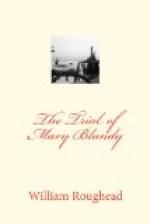Having at length got his would-be son-in-law out of the house, Mr. Blandy determined to be fooled no further; he ordered Mary to write to Cranstoun telling him on no account to show his face again at Henley until his matrimonial difficulties were “quite decided.” Tears and entreaties were of no avail; like all weak characters, Mr. Blandy, having for once put down his foot, was obdurate. This ultimatum she duly communicated to her lover in the North; if we could know in what terms and how replied to by him, we should solve the riddle. Hitherto they seem to have trusted to time and the old man’s continued credulity to effect their respective ends, but now, if Miss Blandy were to secure a “husband” and Cranstoun lay hands upon her L10,000, some definite step must be taken. Both knew, what was as yet unknown to Mr. Blandy, that the appeal had long since been dismissed, and that while his wife lived Cranstoun could never marry Mary. At any moment her father might learn the truth and alter, by the stroke of a pen, the disposition of his fortune. That they openly agreed to remove by murder the obstacle to their mutual desires is unlikely. Cranstoun, as appears from all the circumstances, was the instigator, as he continued throughout the guiding spirit, of the plot; probably nothing more definite was said between them than that the “love powder” would counteract the old man’s opposition; but from her subsequent conduct, as proved by the evidence, it is incredible that Mary acted in ignorance of the true purpose of the wise woman’s prescription.
In April, or the beginning of May, 1751, by Miss Blandy’s statement, she received from her lover a letter informing her that he had seen his old friend Mrs. Morgan, who was to oblige him with a fresh supply of her proprietary article, which he would send along with some “Scotch pebbles” for his betrothed’s acceptance. “Ornaments of Scotch pebbles,” says Lady Russell, “were the extreme of fashion in the year 1750.” According to the opening speech for the Crown, both powder and pebbles arrived at Henley in April; Mary says they did not reach her hands till June. Susan Gunnell, one of the maidservants,




